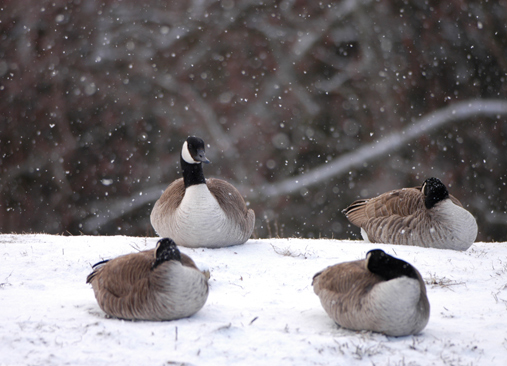BY Lee McClellan
FRANKFORT, Ky. – It happens to even the most seasoned waterfowl hunter. At dawn on a mid-winter day, a gaggle of Canada geese comes honking into your decoys on a farm pond. They look like flying watermelons with wings, a long neck and a black and white head.

You pop up from your homemade blind and excitedly shoot three times at one seemingly close goose. Expecting to hear the thump that follows a successful shot, the big goose flies away instead.
You can’t believe you missed something so big that seemed so close. “It is easy to misjudge the distance of a goose because they are so big, they look closer than they actually are,” said Maj. Shane Carrier, assistant director of law enforcement for the Kentucky Department of Fish and Wildlife Resources. “Also, again, because of their size, they seem like they are flying slower than they really are.”
Carrier, who often hunts Canada geese on farm ponds in Shelby County, said the culprit is an anxious hunter who stops their swing. “If you get excited and just point and shoot,” he said, “you will miss them every time.”
Failing to continue the swing of the gun is one of the common mistakes waterfowl hunters make during the adrenaline rush caused from incoming birds. Stopping the swing causes a miss behind the bird.
“When I swing through and cover the bird, pull the trigger and keep swinging, they crumple and fall down most of the time,” said Rocky Pritchert, migratory bird coordinator for Kentucky Fish and Wildlife. “It is my belief if you put the pellets in the pilot house, they come down. If you hit them in the rear, they keep going.”
When a hunter shoots a shotgun at a moving target, the load doesn’t come out of the gun in the shape of pie pan, like on older cartoons. The swing of the gun’s barrel makes a shot string that is thin on the ends with a bulge in the middle, like a snake that just ate a mouse.
Using too tight a choke restricts this shot string, especially when using steel shot. “Steel shot is harder than lead and tends to hold tighter patterns,” Pritchert said. “If you use too tight a choke, it is like throwing a spear or shooting an arrow at the bird. It overly constricts the shot string.”
Pritchert employs an improved cylinder choke tube for the vast majority of his waterfowl hunting for both ducks and geese. “I shoot improved cylinder 95 percent of the time,” he said. “Using an improved cylinder choke covers up a lot of mistakes. I’ve knocked down some tall birds using improved cylinder.”
Pritchert uses a modified choke for longer shots over 30 yards.
The extended choke tubes that protrude beyond the barrel of the shotgun are growing in popularity. The extra length of these choke tubes allows a little more room for the shot to find its place before exiting the barrel, resulting in tighter, denser shot strings with fewer stray pellets, or fliers.
“I noticed a difference when I switched to them,” Carrier said. “I can get a denser pattern with a lighter load, but they are expensive.”
The belief that comes with using an extended choke tube may be more important than the actual performance benefits. “Anything that gives a person more confidence will improve their shooting,” Pritchert said. “The most important thing is patterning the choke tube with the load you plan to use. Your load may have holes in it. This gives opportunity for birds to slip through those holes.”
Even with the expensive extended choke tubes, there can be considerable variance in performance in shotshells from a different manufacturer within the same shot size or even different-sized shot from the same manufacturer.
To quickly and cheaply pattern your load, take several pieces of 36-inch by 36-inch cardboard and draw a 30-inch diameter circle in it. Shoot the load at 40 yards and look for holes.
“You can refine this by drawing a duck-sized outline in the middle of the circle and see how many hits it has,” Pritchert said.
The recent cold snap froze the surface of many smaller waters in Kentucky. “Once this cold snap breaks, it will loosen up the water,” Pritchert said. “Birds will start looking for new food sources and that will improve hunting.”
When this happens, you will bag more ducks and geese by keeping your gun swinging, using a looser choke and patterning your load.
Author Lee McClellan is an award-winning associate editor for Kentucky Afield magazine, the official publication of the Kentucky Department of Fish and Wildlife Resources. He is a life-long hunter and angler, with a passion for smallmouth bass fishing.
-30-
The Kentucky Department of Fish and Wildlife Resources manages, regulates, enforces and promotes responsible use of all fish and wildlife species, their habitats, public wildlife areas and waterways for the benefit of those resources and for public enjoyment. Kentucky Fish and Wildlife is an agency of the Tourism, Arts and Heritage Cabinet. For more information on the department, visit our website at fw.ky.gov.


Be the first to comment